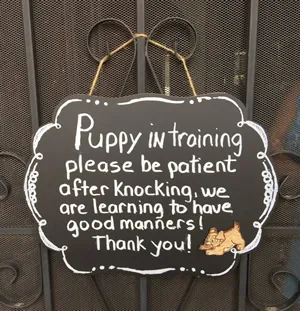One of the most common challenges new puppy owners face is managing their furry friend’s exuberant greetings. While a jumping puppy might seem endearing at first, it can quickly become an undesirable habit, especially as they grow larger. Learning How To Train A Puppy To Not Jump Up is crucial for ensuring they develop into a well-mannered companion who can happily greet people without knocking them over. It’s a balance between fostering early socialization and instilling good manners, and thankfully, it’s a goal every dog owner can achieve. If you’re looking for effective strategies for training your puppy not to jump up, you’re in the right place. The truth is, with a bit of work and forethought, you can have both a well-socialized and well-mannered dog by focusing on two simple steps: preventing bad habits from forming and teaching an alternate behavior.
Prevent Bad Habits
The first golden rule in dog training is that dogs learn best what they learn first. To stop undesirable jumping behavior, you must prevent it from starting. When you have a young puppy, their size makes it easy to keep them in your arms when greeting people, which immediately prevents them from developing the bad habit of jumping up. Remember, dogs do what’s rewarding! If your puppy learns that the most rewarding part of a human (the face) is accessed by jumping, they’ll continue to jump to reward themselves. If your puppy is a large breed and too heavy to be lifted constantly, have people get down to your dog’s level before allowing greetings. This simple act of prevention ensures your puppy doesn’t practice the unwanted behavior.
Teach an Alternative Behavior
This is truly the key to long-term success when teaching a puppy not to jump up. Create an alternative behavior that is physically incompatible with jumping, such as sitting. If your young dog learns to sit consistently for attention, they won’t, or rather they can’t, jump up. Imagine the convenience and peace of mind when your dog automatically sits for attention rather than leaping onto visitors. This strategy is also highly effective for situations like how to train a puppy not to jump on guests. By teaching them to offer a polite sit, you empower them with a desirable way to interact.
Mastering the “Sit” Command
Before your dog can “sit for hello,” they need to master the “sit” command itself. This isn’t just about getting their rear on the floor; it’s about teaching them to sit and hold position until released, regardless of distractions. Use high-value rewards to make sitting a consistently positive experience. Many owners take the “sit” command for granted, assuming their puppy fully understands it. However, if your dog only partially understands “sit,” it can create a fundamental gap in their training. We want your puppy to understand that “sit” means to hold that position stably and for a duration. Gradually add distractions to your training sessions, rewarding your pup handsomely when they make good choices and maintain their sit. This robust “sit” is also invaluable for teaching how to train puppy not to jump on couch or other furniture.
Greeting Etiquette: “Sit for Hello”
Once your dog can hold the “sit” position reliably, it’s time to integrate this into greeting situations. Start simply: have a person approach or stand nearby while you reward your dog for holding their sit. Always use their favorite, high-value rewards to keep the motivation strong. Slowly increase the difficulty and excitement of the greeting. Progress from someone standing nearby to someone speaking to the dog, then to someone gently touching the dog, always rewarding the sustained sit. This gradual exposure helps your puppy understand that calm, polite greetings while sitting lead to positive outcomes. Practicing this will greatly assist you to train puppy not to jump on people in various real-life scenarios.
Generalize Training Across Environments
 A helpful sign indicating a puppy is in training, placed near a doorway to alert visitors.
A helpful sign indicating a puppy is in training, placed near a doorway to alert visitors.
After your dog has learned to sit politely for greetings in a controlled environment, the next crucial step is to generalize this training across different locations and situations. The front door at home is often a major challenge, as the ringing doorbell can trigger immense excitement. Setting up training sessions in this context is invaluable. Begin by enlisting family members or familiar friends who won’t over-excite your dog. Start with the person standing outside with the door closed, then progress to an open door, then ringing the bell with the door open, and finally, the full ritual of a closed door, bell rings, and door opens. By training in a controlled setup, you create and reward success, preparing your dog for real guests. This proactive approach helps your dog apply their polite manners even when excitement builds, which is a core principle in developing a calm and well-behaved companion, much like the temperament desired when you train your dog as a therapy dog.
In the end, it cannot be emphasized enough: dogs do what’s rewarding. By strategically setting the scene and consistently rewarding desired behaviors, your puppy will learn to have both excellent social skills and impeccable manners. Happy training!
